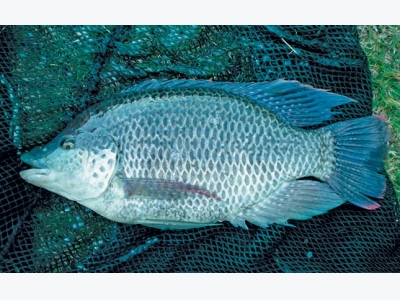Cold-tolerant tilapia can weather winters chill

Taking tilapia cold tolerance ranges into account shows how just a few degrees can make for a worry-free season.
O. mossambicus in the Eastern Cape is more cold-tolerant when adult, and can survive in brackish water as cold as 9,5°C. Tropical races of the same species further north perish at such low temperatures. Photo: Nicholas James
This is the time of year when warm-water fish farmers peer anxiously at their water thermometers to see whether their fish are likely to survive.
Trout farmers, on the other hand, welcome the lower temperatures, for this is when their fish thrive and breed.
In the wild vs in the lab
Tilapia species and races have widely differing tolerances to low temperatures, a fact often not appreciated by state conservation officials.
When considering policy, they tend to regard all species in a genus such as Oreochromis (our blue kurper and Nile tilapia) as if they had similar tolerances.
This is far from true; indeed, there are wide tolerance ranges even within a single species, such as O. mossambicus (blue kurper).

In addition, many reports on tilapia’s cold-tolerance are based on laboratory tests. These are carried out in sterile aquaria, which lack the fungal and parasitic organisms that attack stressed fish in nature.
This can give a false impression. For example, tilapia subjected to a temperature between 8°C and 10°C under laboratory conditions may survive, as organisms that would otherwise kill the fish in the wild are largely absent.
Cold-tolerance ranges
South Africa’s most cold-tolerant tilapia is the vlei kurper, Tilapia sparrmanii. This dwarf tilapia occurs naturally from the Orange River catchment northwards, and east along the KwaZulu-Natal coastal plain.
In these waters, it tolerates temperatures as low as 6°C, which is several degrees lower than those that other tilapia species can tolerate.
Inter-basin water transfers, and stocking by the Department of Environment Affairs in the 1970s for mosquito control and as bass fodder-fish, resulted in their spread to many coastal catchments in the Cape.
The next most cold-tolerant tilapia species is the Eastern Cape population of O. mossambicus. Its natural range extends to the Bushman’s River. Translocations have spread the species to refuges, such as dams, where the water remains a few degrees warmer than those in shallow river pools.
Cold tolerance is also increased by high salinity tolerance; this enables large adult fish to survive at 9,5°C in places in the Eastern Cape.
However, O. mossambicus from warmer regions appears to have a lower tolerance for cold; a 1978 cold front in KZN, during which water temperatures fell below 13°C for some days, caused mass mortalities.
Nile tilapia (O. niloticus) and red breast tilapia T. rendalli, (now sometimes called Coptodon rendalli), are far less cold-tolerant, and die in the wild between 12°C and 13°C.
These differences in cold tolerance are pivotal to establishing sanctuaries for indigenous tilapia species, as these populations can be thermally isolated from invasion by exotic species.
Có thể bạn quan tâm
 Comparing nutritional values of wild and farmed whitefish
Comparing nutritional values of wild and farmed whitefish The aquaculture industry is unique among animal agriculture industries in that there is a near-equal amount of wild-harvested and farmed seafood
 Why aquaculture is stressful for fish
Why aquaculture is stressful for fish Fish species that are adapted for rivers generally perform better under aquaculture’s challenging conditions. Why aquaculture is stressful for fish
 Small scale fish farming
Small scale fish farming With government assistance, many rural small-scale fish farmers could turn their operations into viable enterprises.